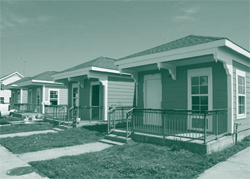April 2008
In this Issue
Are Subdivision Requirements Excessive?
Involving Consumers in Home Energy Management
What Do Grandfamilies Need?
Fostering Local Leadership
In the next issue of ResearchWorks
Are Subdivision Requirements Excessive?
Local governments shape the housing development process with subdivision regulations that dictate infrastructure and site requirements. The primary objectives of these regulations are to ensure that proposed developments meet specified health and safety requirements, are properly designed, and are cost effective, thus minimizing the local governments' long-term maintenance costs. Developers of single-family homes report that complying with subdivision regulations represents a significant expense. The National Association of Home Builders (NAHB) Research Center recently conducted a study for HUD's Office of Policy Development and Research to determine if these regulations exceed what is minimally necessary to achieve their intent, thereby posing unnecessary barriers to affordable housing in many communities across the United States.

Method
To understand the range of subdivision regulations and to quantify the costs of excessive requirements, the NAHB research team collected data on some of the most economically influential subdivision regulations and zoning rules for a nationally representative sample of 469 municipal- and county-level planning jurisdictions. Researchers assembled a team of land and housing experts, including residential land developers, architects, civil engineers, and land planners, to develop benchmarks for the identified subdivision requirements: lot size, floor space requirements, lot width, roadway width, sidewalk requirements, and curb and gutter drainage. The benchmarks set the minimum standards necessary for healthy, sustainable communities.
Subdivision requirements that went beyond the benchmarks were termed excessive and defined as regulatory barriers. The team calculated average regulatory cost estimates for the sample of jurisdictions exceeding benchmark standards. The sample estimate was then used in combination with estimates of single-family building permits from the U.S. Census Bureau’s New Residential Construction statistics to arrive at a national estimate of subdivision regulatory barrier costs.
Findings
Researchers found that 94 percent of the communities mandated one or more land development standards for residential subdivisions. Ninety-one percent had one or more regulatory standards that exceeded the benchmarks, most often exceeding minimums for off-street parking, front setbacks, lot width, and lot size. Among these, the three requirements that gave rise to a disproportionate amount of the excessive regulation were lot size, lot width, and floor area.
-
Lot size regulations accounted for 65 percent of total regulatory costs. Sixty-five percent of jurisdictions in the sample surpassed the benchmarks by an average of 6,573 square feet, or one-seventh of an acre.
-
Excessive lot width standards accounted for 9 percent of total regulatory costs, with 63 percent of jurisdictions surpassing regulation benchmarks. Undue lot width requirements entail additional land and resources, thereby increasing costs to install sewer and water mains and to pave streets.
-
Excessive floor area requirements accounted for 17 percent of total regulatory costs; however, these were attributable to only 8 percent of localities.
The estimated average cost of excessive regulation for one dwelling unit was $11,910, or 4.8 percent of the average cost of a new home in 2004 ($244,000). The report estimates that excessive subdivision regulations cost homebuyers roughly $14.6 billion over the course of the study year. Actual excessive regulatory costs are likely to be greater, since the study only included regulations for the densest zoning districts for single-family detached homes within the sample jurisdictions. If more districts were included, excessive regulatory costs would increase significantly, because residential zones that are less dense generally require larger lot sizes, which result in higher costs.
Conclusion

Researchers concluded that excessive subdivision requirements limit affordable housing by increasing development costs. The analysis calls for localities to reduce regulatory barriers by balancing affordable housing goals with other community benefits. Analysts suggest that HUD’s efforts to reduce regulatory barriers should focus particularly on the largest contributors to excessive subdivision requirements — lot size, lot width, and floor area.
HUD is currently working with states and localities to address regulatory barriers to affordable housing through our Regulatory Barriers Clearinghouse, which collects and disseminates information on the barriers faced in the creation and maintenance of affordable housing, and through the America's Affordable Communities Initiative (http://www.hud.gov/ initiatives/affordablecom.cfm). Information on barriers and solutions to topics such as building and housing codes, fees and dedications, planning and growth restrictions, and zoning and land development regulations is available at www.huduser.gov/rbc.
Study of Subdivision Requirements as a Regulatory Barrier is available as a free download at www.huduser.gov/publications/commdevl/subdiv_report.html, or in print for a nominal fee by calling HUD USER at 800.245.2691, option 1.

